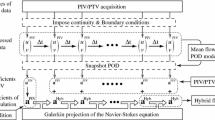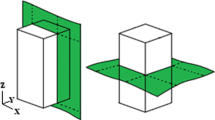Abstract
This investigation compared the application and accuracy of single- and multi-time-delay linear stochastic estimation-proper orthogonal decomposition (LSE-POD) methods in the temporal domain. These methods were considered for low-dimensional estimations of the dynamics of the energy-containing structures in a high Reynolds number flow. The near wake dynamics of a bluff body were used to demonstrate the robustness and accuracy of the investigated LSE-POD methods. Statistically independent two-dimensional particle image velocimetry (PIV) measurements were used to determine spatial POD modes, and time-resolved surface pressure measurements were used to determine LSE coefficients required for estimating the time-varying POD coefficients. A low-order, time-resolved reconstruction of the wake dynamics was accomplished using these estimated time-varying POD coefficients. The paper also provides details concerning the accuracy of the estimation using multi-time-delay LSE-POD. The results demonstrate that the multi-time LSE-POD technique is successful in capturing and reconstructing the important near wake dynamics. It is also shown that optimizing the time delays used for the estimations increases the accuracy of the reconstruction. As a result of its capabilities, the multi-time-delay implementation of the LSE-POD approach offers an alternate method for low-dimensional modeling that is attractive for real-time flow estimation.












Similar content being viewed by others
References
Adrian RJ (1977) On the role of conditional averages in turbulence theory. In: Zaron J, Patterson G (eds) Proceedings of the fourth biennial symposium on turbulence in liquids. Science Press, Princeton, pp 323–332
Adrian RJ (1979) Conditional eddies in isotropic turbulence. Phys Fluids 22:2065–2070
Adrian RJ, Jones BG, Chung MK, Hassan Y, Nithianandan CK, Tung ATC (1989) Approximation of turbulent conditional averages by stochastic estimation. Phys Fluids A 1(6):992–998
Ausseur JM, Pinier JT, Glauser MN (2007) Estimation techniques in a turbulent flow field. AIAA Paper 2007-3975
Berkooz G, Holmes P, Lumley JL (1993) The proper orthogonal decomposition in the analysis of turbulent flows. Annu Rev of Fluid Mech 25:539–75
Bonnet JP, Cole DR, Delville J, Glauser MN, Ukeiley LS (1994) Stochastic estimation and proper orthogonal decomposition: Complementary techniques for identifying structure. Exp Fluids 17:307–314
Bonnet JP, Lewalle J, Glauser MN (1996) Coherent structures, past, present, and future. In: Advances in turbulence: proceedings of the European turbulence conference, vol 6. pp 83–90
Citriniti JH, George WK (2000) Reconstruction of the global velocity field in the axisymmetric mixing layer utilizing the proper orthogonal decomposition. J Fluid Mech 418:137–166
Cole DR, Glauser MN, Guezennec YG (1992) An application of the stochastic estimation to the jet mixing layer. Phys Fluids A 4(1):192–194
Cruz AS, David L, Pécheux J, Texier A (2005) Characterization by proper-orthogonal-decomposition of the passive controlled wake flow downstream of a half cylinder. Exp Fluids 39:730–742
Delville J, Ukeiley L, Coridier L, Bonnet JP, Glauser M (1999) Examination of large-scale structures in a turbulent plane mixing layer. Part 1. Proper orthogonal decomposition. J Fluid Mech 391:91–122
Durgesh V, Naughton JW (2006) Experimental investigation of the wake structure responsible for reduced base drag. AIAA Paper 2006-3186
Durgesh V, Naughton JW (2007) Multi-time-delay LSE-POD complementary approach applied to wake flow behind a bluff body. ASME Paper FEDSM2007-37175
Ewing D, Citriniti JH (1997) Examination of a LSE/POD complementary technique using single and multi-time information in the axisymmetric shear layer. In: Aubry N (ed) IUTAM symposium on simulation and identification of organized structures in flows. Kluwer, pp 375–384
Ewing D, Woodward S (2001) On accurate experimental measurements of the dynamics of large scale structures in turbulent flows. In: Pollard A, Candel S (eds) IUTAM symposium on combustion and mixing. Kluwer, pp 73–83
Glauser MN, George WK (1987) Orthogonal decomposition of the axisymmetric jet mixing layer including azimuthal dependence. Advances in turbulence: proceeding of the European turbulence conference. Springer, Berlin, pp 357–366
Guezennec YG (1989) Stochastic estimation of coherent structures in turbulent boundary layers. Phys Fluids A 1(6):1054–1060
Holmes P, Lumley JL, Berkooz G (1996) Turbulence, coherent structures, dynamical systems and symmetry, 1st edn. Cambridge University Press, Cambridge
Johansson PBV, George WK (2006) The far downstream evolution of the high-Reynolds-number axisymmetric wake behind a disk. Part 2. Slice proper orthogonal decomposition. J Fluid Mech 555:387–408
Lumley JL (1967) The stucture of inhomgeneous turbulent flows. In: Yalglom AM, Tatarski VI (eds) Atmospheric turbulence and radio wave propogation. Nauka, Moscow, pp 166–178
Murray NE, Ukeiley LS (2007) Modified quadratic stochastic estimation of resonating subsonic cavity flow. J Turbulence 8(53):1–23
Naguib AM, Wark CE, Juckenhofel O (2001) Stochastic estimation and flow sources associated with surface pressure events in a turbulent boundary layer. Phys Fluids 13(9):2611–2626
Pinier JT, Ausseur JM, Glauser MN, Higuchi H (2007) Proportional closed-loop feedback control of flow separation. AIAA J 45(1):181–190
Sirovich L (1987) Turbulence and the dynamics of coherent structures—parts 1, 2, and 3. Q Appl Math 45(3):561–590
Spitler JE, Naughton JW, Lindberg WR (2006) An LSE/POD estimation of the wind turbine inflow environment using sparse data. AIAA Paper 2006-1364
Taylor JA, Glauser MN (2004) Toward practical flow sensing and control via POD and LSE based low dimensional tools. J Fluids Eng 126:337–345
Tinney CE, Coiffet F, Delville J, Hall AM, Jordan P, Glauser MN (2006) On spectral linear stochastic estimation. Exp Fluids 41:763–775
Ukeiley L, Murray N (2005) Velocity and surface pressure measurements in an open cavity. Exp Fluids 38(5):656–671
Ukeiley L, Murray N, Song Q, Cattafesta L (2008) Dynamic surface pressure based estimation for flow control. In: IUTAM symposium on flow control and MEMS. Springer, Berlin, pp 183–189
Acknowledgments
The authors wish to acknowledge constructive discussions about LSE-POD with Daniel Ewing, Lawrence Ukeiley, and Charles Tinney, as well as the suggestions provided by the reviewers.
Author information
Authors and Affiliations
Corresponding author
Electronic supplementary material
Below is the link to the electronic supplementary material.
AVI (2878 KB)
Rights and permissions
About this article
Cite this article
Durgesh, V., Naughton, J.W. Multi-time-delay LSE-POD complementary approach applied to unsteady high-Reynolds-number near wake flow. Exp Fluids 49, 571–583 (2010). https://doi.org/10.1007/s00348-010-0821-4
Received:
Revised:
Accepted:
Published:
Issue Date:
DOI: https://doi.org/10.1007/s00348-010-0821-4




